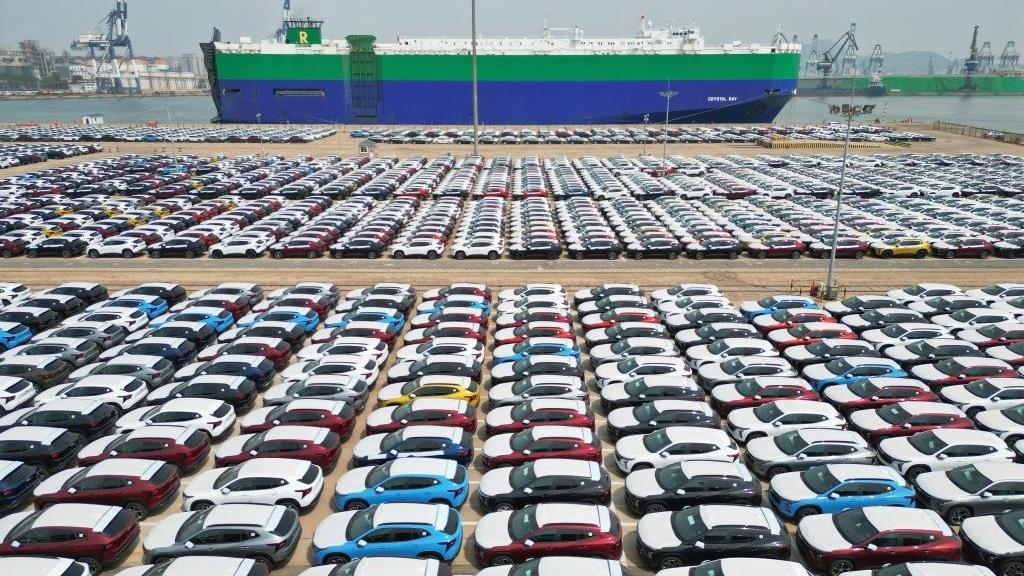Burgeoning auto exports spur construction of vehicle carriers in China
Shipbuilders in China are losing no time to construct vehicle carriers, as the country's surging automobile exports have led to a continuous growth in the demand for the shipment of automobiles.
China's shipping giant, China COSCO SHIPPING Corporation Limited (COSCO SHIPPING Group), has taken the lead in building a fleet of ships serving the country's automobile exports.

This photo shows cars to be loaded for export at Yantai Port, east China's Shangdong province, May 9, 2023. (Photo/Xinhua)
It has set up a special team for supply chain-related tasks to facilitate whole-vehicle exports, kicked off projects for the construction of a digital supply chain of the automobile industry, ordered and built professional ro-ro (roll-on/roll-off) ships, innovated business models, and established service platforms, to provide customers with individualized, custom-made, and diversified solutions to whole-vehicle exports.
Last August, COSCO Shipping Specialized Carriers Co., Ltd., a subsidiary of COSCO SHIPPING Group, jointly established Yuanhai Car Carrier Transportation Co., Ltd. with Shanghai International Port Group Logistics Co., Ltd. (SIPGL) and SAIC Anji Logistics Co., Ltd., a company specializing in automotive logistics services and a wholly-owned subsidiary of Chinese car manufacturer SAIC Motor.
Yuanhai Car Carrier Transportation Co., Ltd. is tasked with the mission of building a world-class professional fleet of vehicle carriers to help Chinese automobiles better explore global markets.
"We have put into service two vehicle carriers with a capacity of 5,000 car spaces after the launch of the shipping route for automobiles between China and Europe," said Zhu Guihua, director and general manager of Yuanhai Car Carrier Transportation Co., Ltd.
According to Zhu, the company has placed orders for 24 ships, which will be delivered before the end of 2026 and bring the total number of the company's vehicle carriers to 30 and its annual capacity for shipping Chinese commodity automobile exports to over 700,000 units.
At the shipyard of Shanghai Waigaoqiao Shipbuilding Co., Ltd., a subsidiary of China State Shipbuilding Corporation (CSSC), workers are busy building vehicle carriers.
"We have orders in hand for 10 vehicle carriers, with the cost of each vehicle carrier standing at around $100 million," Zhang Qipeng, deputy general manager of Shanghai Waigaoqiao Shipbuilding Co., Ltd., told People's Daily Overseas Edition.
"In the past, perhaps we couldn't get one order in a whole year," he added.
More than 90 percent of the automobile exports are transported by sea, with ro-ro ships being the main means of transportation, according to Li Yanqing, secretary-general of China Association of the National Shipbuilding Industry.
There are more than 700 ro-ro ships worldwide, with less than 100 being operated by major sea transportation service providers in China, Li said. He noted that these Chinese operators only have around 10 oceangoing ro-ro ships.
According to Li, the average annual turnover of vehicle carriers in China was four between 2016 and 2020.
"Vehicle carriers represent a niche field of the shipbuilding market, but ship owners are showing a strong demand for upgrading. And shipbuilders have responded quickly to the demand by ramping up efforts to build ro-ro ships. During the past three years, 90 percent of the orders for new vehicle carriers have been placed in China," Li said.
China has significantly accelerated its export of automobiles in recent years. It exported more than 2 million automobiles in 2021 and over 3 million in 2022, according to data from the China Association of Automobile Manufacturers.
Data from the association indicated that the country's automobile exports surged 75.7 percent year on year to 2.14 million units in the first half of 2023. In the first quarter of this year, China overtook Japan as the world’s largest exporter of automobiles.
The robust expansion in automobile exports has resulted in growing demand for automobile transportation. Since last year, automakers in China have found it difficult to book a shipping space on ro-ro ships.
At the Waigaoqiao port area in east China's Shanghai, tens of thousands of new automobiles line up waiting to be shipped abroad every day.
"The area is often filled with automobiles in about two hours," said Liu Jietao, an executive of the operations department of Shanghai Haitong International Automotive Terminal at the Waigaoqiao port area.
In the past, when China's volume of automobile exports was not substantial, automobiles transported at the Waigaoqiao Haitong pier were mainly imports, and most ships arrived at the port area fully loaded with vehicles and left empty, according to Liu.
"Today, three to four times as many automobiles are exported from the port area as are imported," Liu noted.
Soaring exports have placed a sweet burden on automakers and companies specializing in exporting and importing automobiles in the country, as freight costs have been skyrocketing.
"The freight rate of ro-ro ships has increased by about eight times compared to 2020," said Xu Zhongzhan, an executive of an automobile import and export company based in north China's Tianjin Municipality.
"We have production capacity at home and orders from abroad. The difficulty we are facing is the transportation of automobiles. At first we tried to buy a second-hand ship. But since the market is expanding so fast, most ship owners are reluctant to sell ships now,” said Shi Song, an executive of the marketing department of the international shipping business division of SAIC Anji Logistics Co., Ltd.
"The daily rent for a ship with a capacity of 7,000 car spaces has reached $100,000 per day," Shi noted.
Photos
Related Stories
- China to further promote automobile consumption
- Luorong automobile logistics base in Liuzhou ensures transportation of export vehicles
- China's used car sales continue to grow in June
- China's auto exports jump 75.7 pct in H1
- International auto expo opens in northeast China
- China's auto exports surge 56 pct in June
Copyright © 2023 People's Daily Online. All Rights Reserved.









